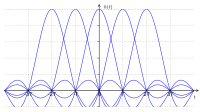
Photo from wikipedia
Orthogonal frequency division multiplexing (OFDM) is a superior technology for the high-speed data rate of wire-line and wireless communication systems. The OFDM has many advantages over other techniques such as… Click to show full abstract
Orthogonal frequency division multiplexing (OFDM) is a superior technology for the high-speed data rate of wire-line and wireless communication systems. The OFDM has many advantages over other techniques such as its high capacity and immunity against multipath fading channels. However, one of the main drawbacks of the OFDM system is the high-peak-to-average power ratio (PAPR) that leads the system to produce in-band distortion and out-of-band radiation because of the non-linearity of the high-power amplifiers. Therefore, numerous techniques have been proposed to overcome the PAPR problem such as selective mapping, partial transmit sequence (PTS), clipping, and nonlinear companding. In this paper, the PTS technique was analytically reviewed as one of the important methods to reduce the high PAPR problem. The PAPR performance and the computational complexity level are discussed in terms of modifying the PTS technique in the frequency domain, time domain and modulation stage (inverse fast Fourier transform block). Moreover, the numerical statistic comparison of the current modified-PTS methods is introduced, and the criteria for selecting the suitable modified-PTS method in the OFDM system are also given. The simulation and the numerical calculations results show that the rows exchange-interleaving PTS scheme is the best method for reducing the PAPR value with low complexly in the frequency domain, and the cooperative PTS method is the best among the modulation stage methods, while the cyclic shift sequence PTS method achieves the superior performance in PAPR reduction and computational complexity for the time domain methods.
Journal Title: IEEE Access
Year Published: 2019
Link to full text (if available)
Share on Social Media: Sign Up to like & get
recommendations!